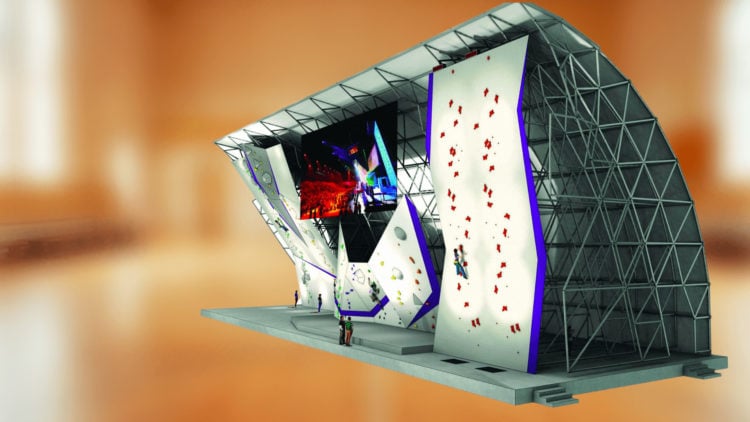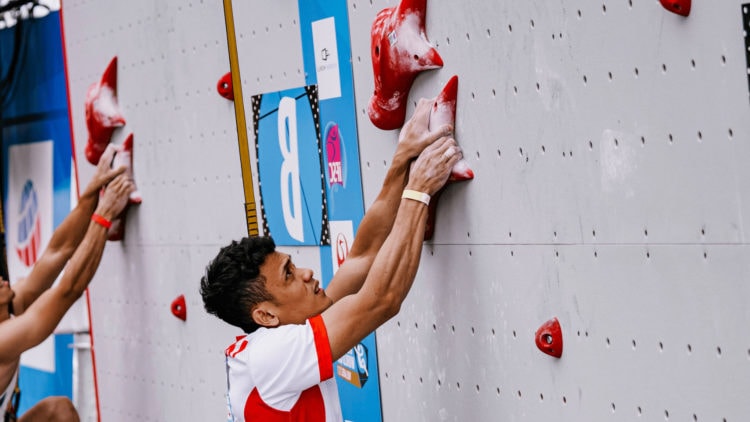
OBJECTIVE OF OLYMPIC ROCK CLIMBING: Get the most points in scaling the rock climbing wall against all other competitors by being the fastest, topping the wall with as few attempts as possible, or getting to the highest point.
NUMBER OF PLAYERS: 2+ players
MATERIALS: Proper footwear, chalk bag, harness, and rope
TYPE OF GAME: Sport
AUDIENCE: 5+
OVERVIEW OF OLYMPIC ROCK CLIMBING
Although more commonly known as rock climbing, in the Olympics, this sport is referred to as sport climbing. There are three disciplines within sport climbing: speed climbing, bouldering, and lead climbing. They all have different rules and different scoring systems. Introduced in the 2020 Tokyo Olympics, this sport is quickly becoming a fan favorite!
SETUP

For Olympic rock climbing, there needs to be a climbing wall. There are three different walls for the three disciplines.
For speed climbing and lead climbing, the wall is 15 meters (49 feet) tall.
For bouldering, there are multiple walls that are 4.5 meters (15 feet) tall.
GAMEPLAY

Speed Climbing
Speed climbing is based on who can get to the top of the 15-meter wall in the shortest amount of time. In Olympic speed climbing, climbers compete in a bracket, two climbers versing at a time. So, even if a climber doesn’t have the best score of the day, as long as they beat the competitor, they can advance to the next round. And so on until the finals.
The speed climbing wall is the same for every competition so that, come competition day, the climb is based on muscle memory.
False Start
A false start is when a climber starts to scale the wall before the buzzer. This can lead to disqualification.
Scoring
Speed climbing scores are based on rank according to the bracket competition.
Bouldering
In boulders, climbers must scale multiple “boulder problems.” Unlike in speed climbing, climbers have no prior knowledge of what the walls look like. And climbers are held in isolated rooms to keep them from watching competitors attempt to scale the boulder problems.
Each problem has a marked starting position that dictates where the limbs must be placed before the climber starts climbing.
The climber’s goal is to get to the top of the boulder securely with both hands on the top hold.
If a climber doesn’t manage to top the boulder, partial credit will be given if the climber gets to the zone hold. The zone hold is the midpoint between the starting position and the top.
Climbers get five minutes per boulder problem with a five-minute rest in between each problem.
Scoring
Bouldering is scored in the following order:
- Number of tops
- Number of attempts
- Number of zones
So, for example, a climber who tops a boulder in one attempt (also called flash) beats a climber who tops it in two attempts. And a climber who tops 2 boulders and reaches 1 zone hold beats a climber who tops 1 boulder and reaches 2 zone holds.
Lead Climbing
Lead climbing is probably the easiest rock climbing discipline to understand. Like in bouldering, lead climbing walls are hidden from the climbers until the competition day. On the day, all of the climbers have a six-minute observation time to look at, but not scale, the lead wall. After this, the climbers must go into isolated rooms until their turn.
Each climber has one attempt and six minutes to scale a 15-meter wall. The aim is to reach the highest point possible by the end of the six minutes.
The climbers must clip their belay rope into the carabiners as they scale the wall.
Scoring
Each of the holds on the lead wall is numbered from 1. Climbers are given scores depending on which hold they stop or fall at. If multiple climbers stop at the same hold, the climber that got to that hold in the shortest amount of time gets the higher score.
END OF GAME
The overall scoring can be done separately or as a combination of the three disciplines. For example in the 2020 Tokyo Olympics, the rank is based on a combination of all three disciplines. And in the 2024 Paris Olympics, the lead climbing and bouldering are a combined event, whilst speed climbing is a separate one.
- 20+ FREE PRINTABLE BABY SHOWER GAMES - April 16, 2024
- 20+ College Party Games for the Best Night Ever! - April 2, 2024
- 31 BEST MOVIE DRINKING GAMES - March 14, 2024